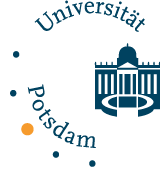Labs at Uni Potsdam
At the BabyLab, the cognitive and psycholinguistic development of children aged four months and older is studied.
In the EyeLab, linguistic, visual, and oculomotor processes are studied. Research focuses on reading, shifts of attention, and other processes loading working memory. In the EyeLab, psychologists, physicists, computer scientists, mathematicians and linguists co-operate closely.
The Social Psychology Laboratory has set its focus on aggression and media research. Topics include the effects of media violence or the risk factors for sexual aggression in young adults.
NOLA (Neurocognition of Language) group is an interdisciplinary team of linguists, psychologists, and neuroscientists. The goal is to characterize language from basic acoustic processing to complex sentence processing regarding its neuroplasticity. This is done by combining behavioral, psychophysiological (eye-tracking), neurophysiological (EEG), and neurovascular (fMRI, NIRS) methods in various populations.
The Potsdam Embodied Cognition Group (PECoG) studies the influence of sensory and motor experiences on knowledge representation with measures of behavior (reaction times, error rates), motion (kinematics analysis, eye tracking, power production) and physiology (body temperature, TMS, EEG, fMRI).
At the lab of the Training and Movement Sciences, the relationship between motor and cognitive abilities in different population groups (e.g. children, adolescents, athletes, employed and retired people ) is investigated using a range of biomechanical techniques.
Central concern of the Vasishth Lab is the research of processes of human understanding of sentences. To this end, the research group, led by Shravan Vasishth, uses mathematical models of syntax analysis and experimental methods, such as eye tracking, self-directed reading and event-related potentials. With the help of the obtained data, predictions of mathematical models can be reviewed and assessed.
The Potsdam Research Institute for Multilingualism (PRIM) investigates the nature of multilingualism in children and adults, including patients with language disorders. Core areas of language processing are investigated using behavioural and physiological techniques such as eye-movement monitoring and electroencephalography.
At the Cognitive Neuroscience Lab (Rabovsky Lab), they combine explicit computational models (specifically, deep learning models) and neuroscientific evidence (mostly event-related brain potentials) in order to understand the neurocognition of language and meaning.
At the Psychophysiology Lab, they use methods like electroencephalography, electrocardiography, electrodermal activity monitoring, electromyography and neurostimulation to understand affective responses related to memory formation and retrieval.










